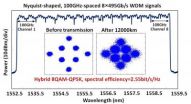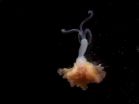(Press-News.org) Infants as young as nine months old prefer individuals who punish those who are not like them, and this seemingly innate mean streak grows stronger in the next five months of life, a study by researchers at Yale University has found.
Babies, like adults, prefer individuals who like the same things they do. A new study reports that they want individuals who share their tastes to be treated well by others, but want those whose tastes differ from their own to be treated badly. The study of 200 nine- and 14-month-old infants was published online in Psychological Science, a journal of the Association for Psychological Science.
Psychologists have long known that people tend to like others who are like themselves. Social bonds form more easily among those who look the same, act the same, have the same interests, and are members of the same group. We deem people who are like ourselves to be more just, intelligent, and trustworthy, while we attribute negative qualities to those who are different from us.
But when do these attitudes arise?
In recent years, Yale's Karen Wynn, professor of psychology and cognitive science, has shown that even before their first birthday, infants too prefer individuals who share their own tastes in food or clothes. Wynn's research team introduced babies to two hand puppets that had expressed contrasting preferences (for example, one preferring green beans to graham crackers, the other preferring the crackers to the beans). Babies who themselves preferred the crackers were much more likely to reach for puppets that liked crackers.
Wynn and lead author, Kiley Hamlin, now of the University of British Columbia, wanted to know if infants' preference for similar individuals meant that they hold negative attitudes toward those who are unlike themselves. In the new study, the researchers introduced babies to a puppet with the same food preference as the baby and to a puppet with the opposite preference. They then introduced two new puppets: One was helpful and retrieved a dropped rubber ball. The other was mean and took the ball away.
As expected babies of both ages preferred the helper over the meanies when the puppet being assisted liked the same food they did. But the next finding surprised the researchers: When the puppet that dropped the ball did not share the babies' taste in food, the infants preferred the mean puppet to the helper. In other words: Babies prefer someone who is nice to an individual similar to themselves, but they also prefer someone who is mean to a dissimilar individual.
However, Wynn, said, the results do not necessarily show that babies are born with a mean streak.
"We were surprised — and more than a little chagrined — to find that babies actively prefer individuals who mistreat someone whose tastes differ from theirs," Wynn said. "But while our findings show that we may be built to dislike differences, we are also built to like similarities — and humans all around the world are similar in a multitude of ways."
It may be that the more similarities babies — and adults — recognize between themselves and others, the less they will want to see those others harmed, said Wynn. When no other information is given, babies appear to dislike someone who differs from them. Their attitude might change if they had more information, she said.
"We don't want to be too quick to generalize. My husband hates cheese, and I love cheese, and we get along just fine," Wynn said. "The interesting question to me is what kinds of information allow us to transcend superficial differences and build on our commonalities."
### Additional authors on the study are Neha Mahajan, and Zoe Liberman. The research was supported by the National Science Foundation and the National Institutes of Health.
Infants prefer individuals who punish those not like themselves, Yale researchers find
2013-03-12
ELSE PRESS RELEASES FROM THIS DATE:
New distance record for 400 Gb/s data transmission
2013-03-12
As network carriers debate the next Ethernet standard—and whether transmission speeds of 400 gigabit per second or 1 terabit per second should be the norm—engineers are working on new measures to squeeze next-generation performance out of current-generation systems.
To that end, a team from AT&T has devised a new patent pending technique enabling tuning of the modulation spectral efficiency, which allows, for the first time, 400 Gb/s signals to be sent over today's 100 gigahertz-grid optical networks over ultra-long distances. Spectral efficiency is the information rate ...
Job burnout can severely compromise heart health
2013-03-12
Americans work longer hours, take fewer vacation days, and retire later than employees in other industrialized countries around the globe. With such demanding careers, it's no surprise that many experience job burnout — physical, cognitive, and emotional exhaustion that results from stress at work. Researchers have found that burnout is also associated with obesity, insomnia, and anxiety.
Now Dr. Sharon Toker of Tel Aviv University's Faculty of Management and her fellow researchers — Profs. Samuel Melamed, Shlomo Berliner, David Zeltser and Itzhak Shpira of TAU's Sackler ...
Ultra-high-speed optical communications link sets new power efficiency record
2013-03-12
Ultrafast supercomputers that operate at speeds 100 times faster than current systems are now one step closer to reality. A team of IBM researchers working on a U.S. Defense Advanced Research Projects Agency (DARPA)-funded program have found a way to transmit massive amounts of data with unprecedentedly low power consumption.
The team will describe their prototype optical link, which shatters the previous power efficiency record by half at the Optical Fiber Communication Conference and Exposition/National Fiber Optic Engineers Conference (OFC/NFOEC) in Anaheim, Calif. ...
New automated process simplifies alignment and splicing of multicore optical fibers
2013-03-12
New multicore optical fibers have many times the signal-carrying capacity of traditional single-core fibers, but their use in telecommunications has been severely restricted because of the challenge in splicing them together-- picture trying to match up and connect two separate boxes of spaghetti so that all of the noodles in each box are perfectly aligned. Now, a new splicing technique offers an automated way to do just that, with minimal losses in signal quality across the spliced sections. The method will be described at the Optical Fiber Communication Conference and ...
Penn study: Financial incentives affect prostate cancer treatment patterns
2013-03-12
Philadelphia - According to a new study by researchers at the Perelman School of Medicine at the University of Pennsylvania, prostate cancer patients of urologists who own expensive radiation equipment are more likely to receive radiation treatment in lieu of surgery than patients treated by urologists without an ownership stake in the equipment. The study, now available online in the Journal of Urology, found that integrated prostate cancer centers (IPCCs), where urology and radiation oncology practices are combined, use expensive radiation-based treatments at higher rates ...
Mystery of 'zombie worm' development unveiled
2013-03-12
How do bone-eating worms reproduce? A new study by Norio Miyamoto and colleagues from the Japan Agency for Marine-Earth Science and Technology sheds light on this question through a detailed observation of the postembryonic development and sexual maturation of Osedax worms, also known as "zombie worms." These worms typically inhabit vertebrate bones on the seafloor. The study is published online in Springer's journal Naturwissenschaften - The Science of Nature.
Osedax is Latin for "bone-devourer," which refers to how the worms bore into the bones of whale carcasses to ...
Neural 'synchrony' may be key to understanding how the human brain perceives
2013-03-12
Despite many remarkable discoveries in the field of neuroscience during the past several decades, researchers have not been able to fully crack the brain's "neural code." The neural code details how the brain's roughly 100 billion neurons turn raw sensory inputs into information we can use to see, hear and feel things in our environment.
In a perspective article published in the journal Nature Neuroscience on Feb. 25, 2013, biomedical engineering professor Garrett Stanley detailed research progress toward "reading and writing the neural code." This encompasses the ability ...
4 dinosaur egg species identified in Lleida
2013-03-12
A study headed by the Miquel Crusafont Catalan Palaeontology Institute has for the first time documented detailed records of dinosaur egg fossils in the Coll de Nargó archaeological site in Lleida, Spain. Up until now, only one type of dinosaur egg had been documented in the region.
The archaeological site in Coll de Nargó containing dinosaur eggs lies some 8 kilometres to the west of the town that bears the same name in the province of Lleida. This region is home to different types of geological formations, including the Areniscas de Arén Formation and the Tremp Formation, ...
Does expressing anger on online rant-sites make you feel better or worse?
2013-03-12
New Rochelle, NY, March 12, 2013—Little is known about the value and emotional consequences of expressing anger on the Internet. Rant-sites provide an outlet for anonymous, angry outbursts. How people feel after reading and writing rants and the effects of this behavior is explored in an article in Cyberpsychology, Behavior, and Social Networking, (http://www.liebertpub.com/cyber) a peer-reviewed journal from Mary Ann Liebert, Inc., publishers (http://www.liebertpub.com). The article is available online on the Cyberpsychology, Behavior, and Social Networking (http://www.liebertpub.com/cyber) ...
Young pigs prefer traditional soybean diet
2013-03-12
Des Moines, IA – Pigs aren't known for being picky, but new research shows they avoid bitter tastes when they can.
In a new study of nursery pig diets, researchers from the University of Alberta offered pigs different amounts of soybean meal, napus canola meal and juncea canola meal. They found that pigs ate more soybean meal when given a choice.
Napus canola meal and juncea canola meal come from rapeseed and mustard greens, respectively. Canola meals are less expensive than soybean meal. If producers can replace soybean meal in swine diets, they could produce pork ...







